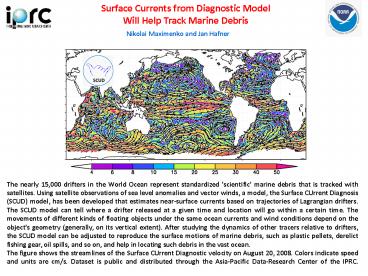Surface Currents from Diagnostic Model PowerPoint PPT Presentation
Title: Surface Currents from Diagnostic Model
1
Surface Currents from Diagnostic Model Will Help
Track Marine Debris
Nikolai Maximenko and Jan Hafner
The nearly 15,000 drifters in the World Ocean
represent standardized 'scientific' marine debris
that is tracked with satellites. Using satellite
observations of sea level anomalies and vector
winds, a model, the Surface CUrrent Diagnosis
(SCUD) model, has been developed that estimates
near-surface currents based on trajectories of
Lagrangian drifters. The SCUD model can tell
where a drifter released at a given time and
location will go within a certain time. The
movements of different kinds of floating objects
under the same ocean currents and wind conditions
depend on the object's geometry (generally, on
its vertical extent). After studying the dynamics
of other tracers relative to drifters, the SCUD
model can be adjusted to reproduce the surface
motions of marine debris, such as plastic
pellets, derelict fishing gear, oil spills, and
so on, and help in locating such debris in the
vast ocean. The figure shows the streamlines of
the Surface CUrrent Diagnostic velocity on August
20, 2008. Colors indicate speed and units are
cm/s. Dataset is public and distributed through
the Asia-Pacific Data-Research Center of the
IPRC.
PowerShow.com is a leading presentation sharing website. It has millions of presentations already uploaded and available with 1,000s more being uploaded by its users every day. Whatever your area of interest, here you’ll be able to find and view presentations you’ll love and possibly download. And, best of all, it is completely free and easy to use.
You might even have a presentation you’d like to share with others. If so, just upload it to PowerShow.com. We’ll convert it to an HTML5 slideshow that includes all the media types you’ve already added: audio, video, music, pictures, animations and transition effects. Then you can share it with your target audience as well as PowerShow.com’s millions of monthly visitors. And, again, it’s all free.
About the Developers
PowerShow.com is brought to you by CrystalGraphics, the award-winning developer and market-leading publisher of rich-media enhancement products for presentations. Our product offerings include millions of PowerPoint templates, diagrams, animated 3D characters and more.

